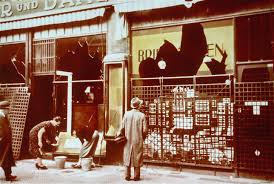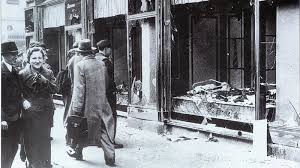
Nazi leaders released a series of pogroms against the Jewish Population in Germany and recently incorporated territories on November 9–10, 1938. This event became known as The Night of Broken Glass or, more popularly, Kristallnacht.
The name was influenced by the shattered glass that littered the streets after the vandalism and destruction of Jewish-owned businesses, synagogues, homes and schools.
This wave of violence happened throughout Germany, some parts of Austria, and Czechoslovakia. This attack was instigated by members of Sturmabteilung: commonly known as Storm Troopers, Hitler Youth and Nazi Party officials.
Nazi officials disguised the organised nature of the pogroms the same way they hid the holocaust. They described the actions as a justifiable response of the German population due to the assassination of a German diplomatic official, Ernst vom Rath, in Paris. This violence against the Reich’s Jews generated public outrage.
A 17-year-old Polish Jew, Herschel Grynszpan, shot the diplomat on November 7, 1938, as a result of the fact that a few days earlier, the German authorities had expelled thousands of Jews of Polish citizenship living in Germany from the Reich; and his parents who had been residents in Germany since 1911 were among them.
On November 9, 1938, two days after the shooting, Vom Rath died. This was also the anniversary of the 1923 Beer Hall Putsch, when the Nazi officials gathered to launch racist and anti-semantic laws.
A chief instigator of the Kristallnacht pogroms, Propaganda minister Joseph Goebbels, suggested that the Jews had conspired to assassinate Ernst vom Rath. He said that retaliations would not be organised by the party, but if they happened spontaneously, they shouldn’t be stopped.
After this speech, violence was unleashed. Regional Party leaders gave instructions to their local offices, and in various parts of the Reich throughout the late evening and early morning hours of November 9–10, violence erupted.
The head of the security police gave directives concerning the riots. Members of many units wore civilian clothes to support the fiction that the disturbances were expressions of ‘outraged public reaction.’ The orders also directed that the police officials should arrest as many Jews as the local jails could hold, preferably young, healthy men.

Many synagogues were burned throughout the night in full view of the public and local firefighters, who were given orders to intervene only so that flames won’t spread to nearby buildings. The SA and Hitler Youth members across the country shattered the shop windows of an estimated 7,500 Jewish-owned commercial establishments and looted their wares. Jewish cemeteries became a particular object of desecration in many regions.
In Berlin and Vienna, mobs attacked Jews in their houses and forced them to perform acts of public humiliation. Police records of the period also document many rapes, murders and suicides in the aftermath of the violence. Over 30,000 Jewish males were arrested and transferred from local prisons to concentration camps.
The Kristallnacht was the Nazi regime incarcerated Jews on a massive scale because of their ethnicity.